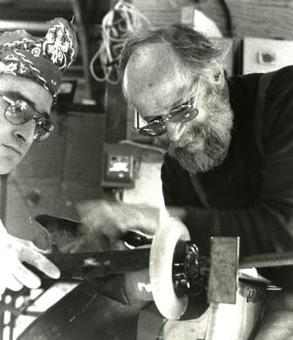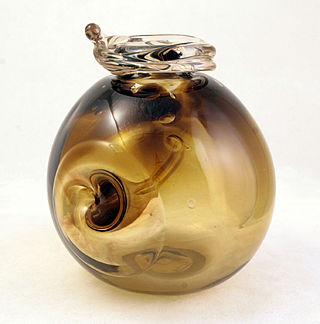The topic of this article may not meet Wikipedia's notability guideline for biographies .(June 2018) |
Gary Beecham | |
|---|---|
| Born | April 21, 1955 |
| Nationality | U.S. citizen |
| Occupation | Glass artist |
Gary Beecham is a studio glass artist of North Carolina.
The topic of this article may not meet Wikipedia's notability guideline for biographies .(June 2018) |
Gary Beecham | |
|---|---|
| Born | April 21, 1955 |
| Nationality | U.S. citizen |
| Occupation | Glass artist |
Gary Beecham is a studio glass artist of North Carolina.
Beecham's attended the University of Wisconsin–Madison, where he was awarded a Bachelor of Science in Art in 1979. He worked for a year in 1978 at the J. & L. Lobmeyr glassworks in Vienna, Austria before returning to the United States to settle in Spruce Pine, North Carolina. There he worked from 1980 to 1985 as an assistant to Harvey Littleton. Thereafter Beecham began his own career in glass, creating in the techniques of free-blowing, fusing and carving glass.
Beecham's work has been collected by the Glasmuseet Ebeltoft, Ebeltoft, Denmark; Düsseldorf Art Museum in Ehrenhof, Düsseldorf; Frauenau Glass Museum, Germany; Asheville Art Museum, Asheville, North Carolina; High Museum of Art, Atlanta, Georgia and Mint Museum of Art, Charlotte, North Carolina.

Ebeltoft is an old port town on the central east coast of Denmark with a population of 7,204. It is located in Syddjurs municipality in Region Midtjylland on the larger Djursland peninsula of Jutland.

František Janák is a Czech glass artist. He creates glass sculptures and commission works, and also does series production design for different Czech glassworks.

Harvey Littleton was an American glass artist and educator, one of the founders of the studio glass movement; he is often referred to as the "Father of the Studio Glass Movement". Born in Corning, New York, he grew up in the shadow of Corning Glass Works, where his father headed Research and Development during the 1930s. Expected by his father to enter the field of physics, Littleton instead chose a career in art, gaining recognition first as a ceramist and later as a glassblower and sculptor in glass. In the latter capacity he was very influential, organizing the first glassblowing seminar aimed at the studio artist in 1962, on the grounds of the Toledo Museum of Art. Imbued with the prevailing view at the time that glassblowing could only be done on the factory floor, separated from the designer at his desk, Littleton aimed to put it within the reach of the individual studio artist.
Marvin Bentley Lipofsky was an American glass artist. He was one of the six students that Studio Glass founder Harvey Littleton instructed in a program at the University of Wisconsin-Madison in fall 1962 and spring 1963. He was a central figure in the dissemination of the American Studio Glass Movement, introducing it to California through his tenure as an instructor at the University of California, Berkeley and the California College of Arts and Crafts.

Dominick Labino (1910–1987) was an internationally known scientist, inventor, artist and master craftsman in glass. Labino's art works in glass are in the permanent collections of more than 100 museums throughout the world. Labino held over 60 glass-oriented patents in the United States.

Richard "Dick" Marquis is an American studio glass artist. One of the first Americans ever to work in a Venetian glass factory, he became a master of Venetian cane and murrine techniques. He is considered a pioneer of American contemporary glass art, and is noted for his quirky, playful work that incorporates flawless technique and underlying seriousness about form and color.

Stanislav Libenský and Jaroslava Brychtová were contemporary artists. Their works are included in many major modern art collections, such as the Metropolitan Museum of Art and the Victoria & Albert Museum.

Vitreography is a fine art printmaking technique that uses a 3⁄8-inch-thick (9.5 mm) float glass matrix instead of the traditional matrices of metal, wood or stone. A print created using the technique is called a vitreograph. Unlike a monotype, in which ink is painted onto a smooth glass plate and transferred to paper to produce a unique work, the vitreograph technique involves fixing the imagery in, or on, the glass plate. This allows the production of an edition of prints.

Robert C. Fritz was an American ceramics and glass artist and professor at San Jose State University in California. As a major player in America’s mid 20th century studio glass movement, Dr. Robert Fritz is remembered for his contributions to the world of art.

Erwin Eisch was a German artist who worked with glass. He was also a painter, draughtsman, and printmaker. Eisch's work in glass, along with that of his friend and colleague Harvey Littleton, embodies the ideas of the international studio glass movement. Eisch is considered a founder of the studio glass movement in Europe.

John Littleton and Kate Vogel are American studio glass artists who have worked collaboratively since 1979. They are considered to be among the third generation of American Studio Glass Movement artists who trace their roots to the work of Harvey Littleton in the 1960s. John Littleton, the youngest child of Harvey Littleton, grew up in the shadow of his father's accomplishments in Madison, Wisconsin, where he experienced first-hand the personalities and events of the early glass movement. Glass, however, was not John Littleton's first medium of choice when it came time for him to select a career. It was only after majoring in photography at the University of Wisconsin–Madison that he began to create in glass. He soon formed a collaborative partnership with another art student, Kate Vogel, who had exchanged her study of two dimensional art for glass. The artists' earliest collaborations in glass were the bag forms for which they are well known today. Since 2000 their work has included a series of arms and hands cast in amber-colored glass. Over the years the hands have held various objects, including river stones, large faceted glass "jewels", and colorful cast glass leaves. In recent years Littleton and Vogel have also become known for their series of functional glass and wrought iron side tables.

Richard Ritter is an American studio glass artist who lives in North Carolina.

Glasmuseet Ebeltoft is a museum in Ebeltoft, Denmark. It is dedicated to the exhibition and collection of contemporary glass art worldwide and also offers public demonstrations and seminars to glass students in its glass-blowing studio.
Michael Taylor is an American studio glass artist, teacher and lecturer. His best known body of work is his geometric glass sculptures. He works the glass cold, shaping, polishing and laminating translucent colored and clear blocks of glass together using epoxy resin.
Fritz Dreisbach is an American studio glass artist and teacher who is recognized as one of the pioneers of the American Studio Glass Movement.
Sam Herman was contemporary glass artist, sculptor and painter. One of Harvey Littleton's first students, Herman is credited as one of the founders of the Studio Glass movement in Great Britain. He was seminal in spreading the idea of the movement through his teaching positions in England,, and Australia and through the exhibition of his own sculpture in glass. Through the years the artist has resided and established his personal studio in London, England (1979–90), South Australia (1974–79). From 1993 to his final years he maintained studios in Spain, London and Gloucestershire. Sam was represented by The Frestonian Gallery (London).
Norm Schulman was an American ceramic artist who lived in Penland, North Carolina. He was born in New York City in 1924. He operated his own studio, Norman Schulman Studio, in Penland.
Shane Fero is an American artist and glass blower.
Sybren Valkema (1916–1996) was a Dutch glass artist and teacher, and founder of the European Studio Glass Movement, also known as VRIJ GLAS.
Anna Carlgren, born July 1960, in Växjö, Sweden, is a glass artist.